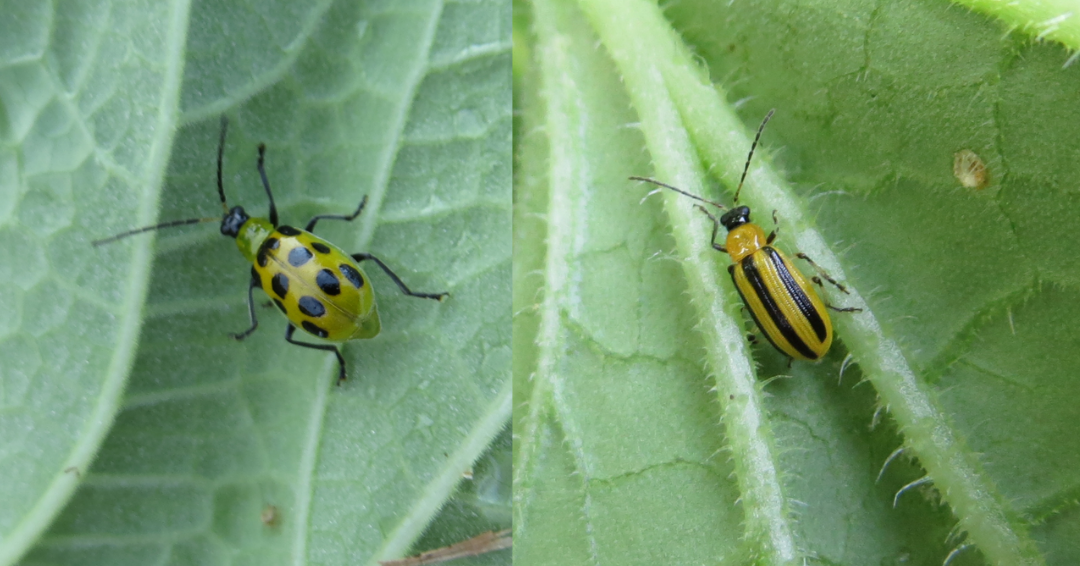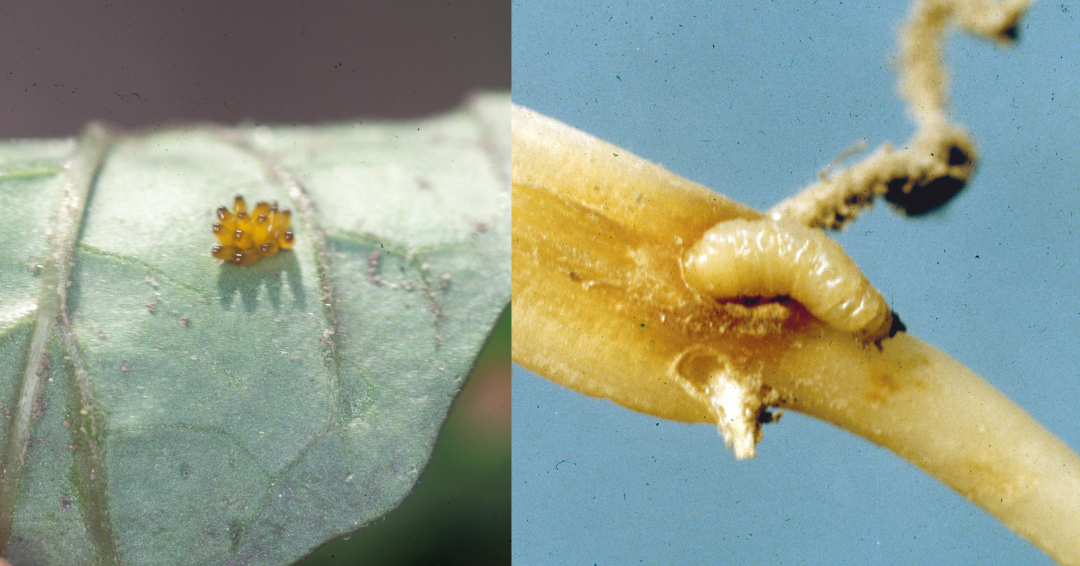Spotted Cucumber Beetle
Striped Cucumber Beetle


Description
Adult: Spotted cucumber beetle: About 1/3 inch (8-9 mm) long with a black head, yellow prothorax (segment behind head), and 12 black spots on yellowish green wings with black legs and black antennae. Striped cucumber beetle: About 1/3 inch (8-9 mm) long with a black head, yellow prothorax, and alternating yellow and black stripes on yellow wings.
Egg: Oval shaped, with yellow to orange coloring. Eggs are laid near or at the base of cucurbit plants in groups of 200-1,200 and need soil moisture to survive.
Larva: About 1/3-1/2 inch (8-13 mm) long with a wormlike, white to yellowish-white body, a brown head, and three pairs of brown legs. Pupa: About ½ inch (6 mm) long with a white to yellow body. Pupation occurs in the soil.
Life History
Cucumber beetles overwinter as adults in protected outdoor areas. They become active and start mating at temperatures above 50°F in the spring. Eggs hatch in 7-10 days and larvae take about 15 days to complete development. Pupae live about 7 days before becoming adults. In east central Utah, two summer generations occur.
Damage
Both adults and larvae of the striped cucumber beetle are pests, whereas only the adult stage of the spotted cucumber beetle is a pest. This makes the spotted cucumber beetle a less severe pest of cucurbits than the striped cucumber beetle.
Striped cucumber beetle larvae chew on roots, reduce plant stands, and stunt or kill cucurbit plants. Larvae can also feed on fruit rinds that are touching the soil. Smooth-skinned cucurbits such as watermelon, honeydew, crenshaw, and casaba are highly susceptible to damage. Adults of both species feed on immature fruit with soft rinds as well as stems, leaves, and flowers. Injured stems can break during high winds, causing reduced plant stands and reduced runners. Both the spotted and striped cucumber beetles are vectors for diseases.
Other hosts of the cucumber beetles include corn, potato, tomato, bean, and ripening fruits.
Monitoring
- Monitor by visual scouting. Newly emerged or transplanted cucurbits should be inspected two or three times per week. Scout the field margins in the early season and if adult beetles are detected, scout random locations in the center of fields.
- Monitor with traps. When populations are high, beetles can be monitored with yellow sticky traps
Management
Early season management of cucumber beetles is crucial for success. Start monitoring for adult beetles when seedlings emerge or after transplanting, and through the fruiting stage.
Cultural
- Choose less susceptible varieties. Cucumber beetles have lower preference for some varieties of cucurbits, including:
Summer Squash: ‘Yellow Crookneck’ (crookneck), ‘Peter Pan’ (scallop), ‘Goldbar’, ‘Seneca Prolific’ (straightneck), ‘Slender Gold,’ ‘Sunbar’ (yellow)
Winter Squash: ‘Carnival, ‘Table Ace’ (acorn), and ‘Butternut Supreme’, ‘Zenith’ (butternut)
Pumpkin: ‘Baby Pam’, ‘Jack-Be-Little’, ‘Jackpot’, ‘Munchkin’, ‘Seneca Harvest Moon’, ‘Tom Fox - Delay planting until late May, after beetles have laid their first generation of eggs. Because of the short growing season in Utah, this is more practical for cucumber and summer squash crops (although delayed planting would eliminate early harvests).
- Lure beetles away with trap crops. Trap crops such as ‘Black Sack’ or ‘Dark Green’ zucchini can help lure cucumber beetles away from the main crops, and help to monitor their populations. Physically remove or treat trap crops while beetles are present.
- Use floating row covers, where practical to prevent adult beetles from landing on plants in the spring. Remove covers during flowering for pollination.
- Use plastic or organic mulches and drip irrigation. Mulches will deter cucumber beetles from laying eggs in the ground near host plant stems. Mulch and targeted irrigation reduces the occurrence of direct contact between fruits and moist soil, and therefore reduces cucumber beetle feeding on fruits.
- Avoid planting near other host plants and remove weeds. See the list of hosts above in the damage section.
- Limit irrigation near harvest. Using drip irrigation will decrease the chance of crop injury from moisture-loving cucumber beetles during mid- and late-summer.
- Destroy crop residues with thorough and deep cultivation after harvest. This will accelerate the decomposition of residues (especially roots and fruits) that may be hosts to overwintering populations of cucumber beetles.
- In highly infested organic farms, use bug vacuums to remove beetles from trap crops or main crops.
Chemical
Combine cultural, mechanical, and biological tactics for long-term management. When using insecticidal sprays, ensure thorough coverage of plants and soil surface so that it contacts the larvae and/or adult beetles. Treatments should target susceptible life stages as follows:
- Spring: overwintered adults. Treat before feeding injury is significant and before mating and egg-laying.
- Late spring and early summer: larvae. Treat when eggs hatch and before larvae move to plant roots to feed.
- Mid and late summer: adults and larvae. Treat high number of adults and larvae to prevent feeding damage to leaves, stems, flowers, and fruits.
- Early-season control of overwintering adults. Time insecticides to target the overwintering generation early in the season. This may be less practical in larger cucurbit production fields as adult beetles may migrate from nearby infested fields, despite early-season control.
Biological
Natural enemies of cucumber beetles include ground beetles, soldier beetles, braconid wasps, tachinid flies, and entomopathogenic nematodes. Nematodes can suppress larvae and pupae in the soil while the others attack adults, eggs, and larvae. Promote beneficial organisms by developing healthy soil, weed, and pest management practices.

